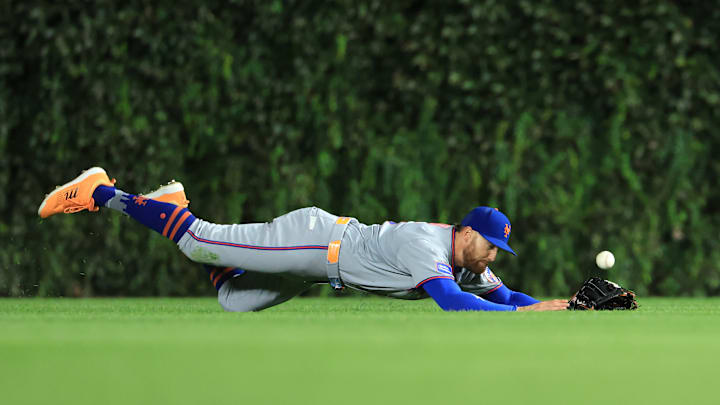When the New York Mets signed Brandon Nimmo to an eight-year, $162 million deal in December of 2022, they thought they were locking up their do-it-all center fielder for the long haul.
Nimmo's offensive profile was one of superb contact and on-base skills with just enough power to be a threat. Defensively, he was athletic and was coming off a year in which he posted six outs above average while roaming center field. The total package made him a star, even if none of his skills stood out as elite on their own.
Nimmo battled plantar fasciitis throughout the 2023 campaign, his first under that monster contract, and saw his defensive performance drop off as a result. With -1 out above average in 2023, he went from solidly above average in center to slightly below, and a move to left field was in his future.
Since then, it's been a hot and cold defensive performance for Nimmo. Part of the issue has been Nimmo's offensive skills, with the exception of his power production, declining to the point where becoming a full-time (or majority) DH wasn't feasible.
The Texas Rangers believe that they have a solution to the Brandon Nimmo conundrum. It's one that the Mets never really strongly considered — playing him in right field.
Mets fans will watch with interest as the Rangers try to shift Brandon Nimmo to right field despite an obvious weakness
When it comes to the outfield corners, which position is more difficult is somewhat dependent on the park one is playing in. Some right fields are more spacious than left fields, and vice versa. Some parks, like Fenway Park in Boston, have unique features that a fielder has to contend with, requiring a specialized skill set. There is one constant, however, and that is having a right fielder with better arm strength than his left field counterpart.
Texas plays its home games in Globe Life Field, and at first glance, playing Nimmo in right makes more sense given his mobility issues. At home, the Rangers see right field being the (slightly) smaller yard, with it being 326 feet down the right field line and 374 in the right field power alley.
That's a bit smaller than the left field pasture Nimmo roamed in Citi Field, and while having less ground to cover is helpful, there is a problem.
Nimmo doesn't have a typical right fielder's arm. His Statcast arm value in 2025 was neutral at 0, and his 83.9 miles per hour average velocity was a 48th percentile mark.
An outfielder can sometimes partially make up for a subpar throwing arm with exceptional range and speed, and while that was part of Nimmo's game in his early days, he no longer possesses those tools.
If Texas were straight-up rebuilding, this wouldn't matter much, but part of the reason they opted for Nimmo is that they want to compete while shedding payroll, making the decision that much more questionable.
